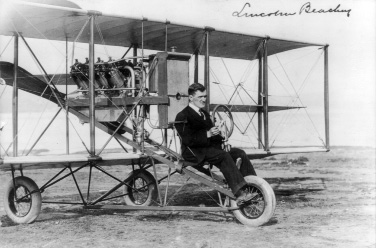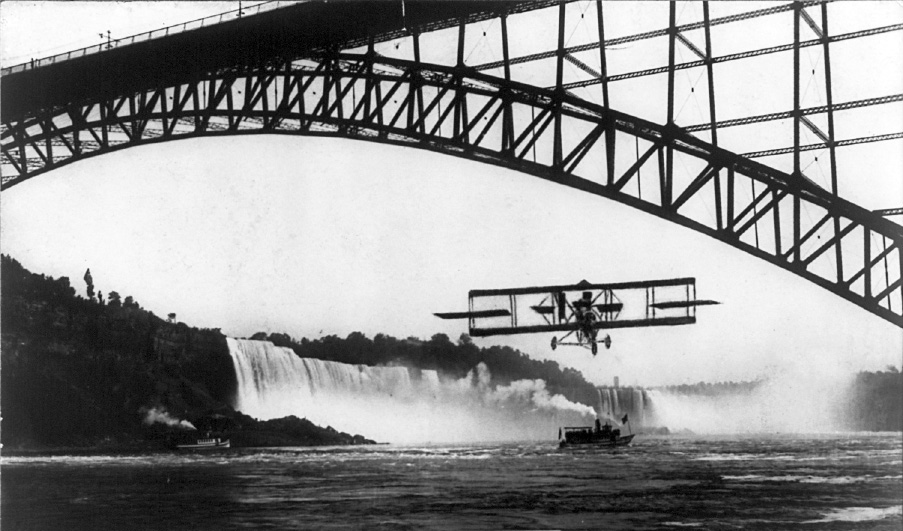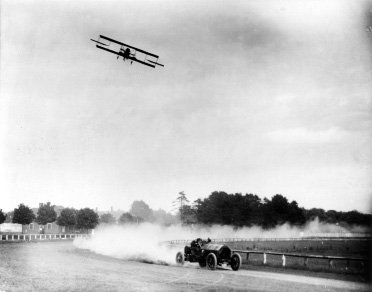2
Insanity in a Pinstripe

Just eight years after the Wright brothers’ historic first flight in 1903, a sharply dressed pilot loaded up the gas tanks of his flimsy-looking plane and announced to the watching crowd that he intended to fly straight up into the sky till his fuel ran out. For over an hour and three-quarters he spiralled upwards until finally his engine sputtered and died. Then, in what seemed like a suicidal plunge, he tumbled back down before levelling out just above the ground and gliding to a safe landing. The plane’s pressure gauge showed that he had peaked at 11,578 feet – a new world altitude record. That’s how Lincoln Beachey rolled. One of the most naturally gifted aviators who ever lived, he was arrogant, brilliant, and a consummate showman.

4 Lincoln Beachey seated at the controls of his plane (1913).
Born in San Francisco in 1887, Beachey began tinkering with machines at an early age and opened his own bicycle shop when he was thirteen. A couple of years later he graduated to fixing motorcycles and their engines. Soon after that, he joined the performing stunt team run by pioneering balloonist and former circus trapeze artist Thomas Baldwin, starting out as a mechanic and quickly moving on to becoming a pilot as well. In 1900 Baldwin got into the business of building dirigibles – rigid airships powered by small engines. Beachey helped Baldwin put together a dirigible called California Arrow, propelled by a motorcycle engine supplied by Glenn Curtiss, who would go on to found the US aircraft industry. In 1905, still only seventeen, Beachey took the controls of the California Arrow and made his first solo flight. There and then he was hooked, and shortly after went into the dirigible business himself, advertising his airship in a style that no one would get away with today – flying it around the Washington Monument and down the Mall, before cheekily touching down on the White House lawn.
More and more obviously, though, the future lay with planes and, grasping this, Beachey signed up for lessons at the Curtiss Flying School in San Diego. He quickly mastered the Curtiss Model D biplane – the first aircraft in the world to be built in any quantity – and was put on the company’s exhibition team. But like many geniuses, Beachey was as stubborn as he was talented and managed to smash up several planes while attempting extreme manoeuvres before emerging as the team’s star performer and Curtiss’s top money-spinner. Whenever he flew he dressed as if he was on a big night out, complete with pinstripe suit, high collar, fancy tie, and golf cap turned fashionably backwards. Crowds would gasp as he did his signature stunt – the ‘Dip of Death’. In this, he would climb his plane to 4,500 feet, then plummet towards the ground at full speed with his arms outstretched. At the last moment he levelled out, gripping the control stick with his knees and waving with both hands to his adoring fans.
The years 1908 to 1915 spanned the ‘exhibition era’ of early aviation, when promoters staged extraordinary stunt shows to enthuse the public in the new heavier-than-air flying machines. This was the time when people started to get excited about not just the tricks that aircraft could perform but the possibilities for their practical uses in the future. It was the age when the focus of attention shifted from airships to aeroplanes. And the greatest of the exhibitioners – the man who commanded the biggest salary and audiences – was Lincoln Beachey.
No stunt too extreme
Beachey first won international fame when, on 27 June 1911, he diced with death above Niagara Falls. Taking off from an airport in New York, he arrived at the falls and circled several times over an estimated 150,000 spectators before plunging down towards the mist and spray in the gorge. Pulling up just twenty feet above the turbulent river, he then continued down the gorge before astonishing onlookers by flying under the arch of Honeymoon Bridge (also known as Fallsview Bridge). Later that year, he flew above a speeding train and brushed his wheels against the top of the carriages as they passed beneath him.

5 Lincoln Beachey’s flight under Niagara Falls Bridge, 27 June 1911.
With every stunt, Beachey grew more bold and ambitious. In a profession with a devastatingly high mortality rate, he wanted to push himself and his machine to the absolute limit. In 1913, he became the first to fly a plane entirely indoors. Taking off inside the Machinery Palace on the Exposition grounds at the San Francisco World’s Fair, he circled his plane around and around at sixty miles per hour before landing again, all within the confines of the hall.
Whenever Beachey heard of others who had pioneered new stunts, he immediately wanted to master the tricks himself and then give them his own special twist (sometimes quite literally). On 21 September 1913, a French aviator, Adolphe Pégoud, working as a test pilot for the great Louis Blériot, performed an inside loop – flying horizontally at top speed before pulling back on the control stick and doing a complete vertical circle. Pégoud thought his loop was a world’s first but it turned out that he’d been beaten to it, twelve days earlier, by a Russian military pilot called Pyotr Nesterov at an army airfield near Kiev. Both men had flown monoplanes (single-wing aircraft) that were more manoeuvrable and equipped with more powerful engines than anything that Beachey had access to.
The American was desperate to do the loop himself and urged Glenn Curtiss to build him a plane that would make it possible. When Curtiss refused, Beachey stormed out of the flying team and, in what may have been more a fit of pique than anything else, composed a melodramatic essay in which he wrote: ‘I was never egotistical enough to think that the crowds came to witness my skill in putting a biplane through all the trick-dog stunts. There was only one thing that drew them to my exhibitions … They paid to see me die. They bet I would, and the odds were always against my life, and I got big money for it.’ On 7 March 1913, he announced that he had quit professional flying because so many young aviators had been killed trying to copy his stunts.
Ins and outs and loop-the-loops
Beachey’s retirement proved to be brief, however. Within a few months Curtiss relented and stumped up the funds to build a plane powerful enough to tackle the loop. On 7 October, Beachey was behind its controls at Hammondsport, New York, ready to add to his aerobatic prowess. But the flight went badly wrong. As Beachey banked around over the airfield, shortly after take-off, a downdraft or possibly a mechanical glitch caused the plane to dip, sweeping two naval officers and their lady companions off the roof of a hangar from which they had been hoping to get a perfect view of the event. Beachey’s plane ended up a mangled wreck in a nearby field, although the aviator himself escaped with only minor injuries. Not so fortunate was one of the women, who died from her fall.
Beachey quit aviation a second time after the accident but, again, only temporarily. A circus poster depicting a plane flying upside down – a stunt never before attempted – fired his imagination. He simply had to get back into the cockpit and master both the loop and flying horizontally with his head pointing at the ground. This time he opted to go it alone, without the backing of a big company. After conquering the loop, which he went on to repeat many hundreds of times, he wrote in his usual theatrical style: ‘The silent reaper of souls and I shook hands that day. Thousands of times we’ve engaged in a race among the clouds. Plunging headlong in to breathless flight, diving and circling with awful speed through ethereal space … I have imagined Him close at my heels. On such occasions I have defied him … Today, the old fellow and I are pals.’
Beachey’s problem was that he needed to make a living by charging people to come to his displays, so he did his flying only over exhibition grounds to which there was an admission fee. But because the stunts took place well off the ground, people could just as easily watch for free from a distance – which is exactly what many of them did. Frustrated by his lack of income, the imperious airman retired for a third time. But, unsurprisingly, not for long.

6 Lincoln Beachey in his plane racing against Barney Oldfield, 28 June 1912.
Race to fame
It so happened that Beachey shared a publicity agent with a well-known racing-car driver called Barney Oldfield. The agent hatched an ingenious plan that would put both Beachey and Oldfield firmly in the public eye and force people to pay if they wanted to see the action. Eye-catching posters were printed in which the ‘Demon of the Sky’ was shown pitted against the ‘Daredevil of the Ground’. All over the country, on courses surrounded by a high fence to ensure there were no freebies, Beachey and Oldfield raced for ‘The Championship of the Universe’ – Beachey flying a new plane he had designed and built himself, called the ‘Little Looper’, which had B-E-A-C-H-E-Y painted in three-foot-high letters on its upper wing, against Oldfield’s famous red 100-horsepower Fiat. Crowds flocked to see the spectacle – 30,000 strong in Dayton, Ohio, home of the Wright brothers – and thrilled as the two vehicles, throttles open wide, unmuffled engines roaring, sped past the grandstand, with clouds of dust billowing from the wheels of the big car. Although Beachey’s plane was faster, the whole affair was staged so that the stars of the show knew exactly who would ‘win’ each time. After the pair crossed the finishing line, always nearly neck and neck, Beachey would soar up into the sky and put on a breathtaking aerobatic display – adding more and more loops as time went on, in order to keep ahead of the records set by other stunt pilots. Eventually, he was doing as many as eighty loops, one right after the other.
As well as his mock races with Oldfield, Beachey took his solo aerial shows to no fewer than 126 cities around the US between May and December 1914. In total, 17 million Americans turned out in that frenetic seven-month period to watch the Little Looper put through its paces, and everywhere he went the ‘Alexander of the Air’, as the press hailed him, was given superstar treatment. In the summer of 1914, Beachey also achieved another of his long-held ambitions – to fly in front of the great Thomas Alva Edison.
‘I want to show such men as Henry Ford, Thomas Edison and other inventive and manufacturing geniuses’, he said, ‘how I handle the Little Looper. I do not believe they dream such things are possible … I want to open the eyes of the people to the possibilities of the aeroplane. My tour this summer will help advance the science of flying by ten years.’
He certainly made a lasting impression on Edison. ‘I was startled and amazed,’ said the inventor, ‘when I saw that youngster take to the sky and send his aeroplane through the loop and then follow that feat with an upside-down flight. I could not believe my own eyes, and my nerves were a tingle for many minutes.’
Another famous engineer who came in for a surprise that summer was Orville Wright. He’d earlier doubted that Beachey actually flew loop-the-loops or upside down. ‘It is probably done high in the air,’ said Wright, ‘3,000 feet or so, an optical illusion and promoter’s hype.’ Some of his scepticism probably stemmed from a feud that had been going on between Glenn Curtiss and the Wright brothers for several years and that had come to a head after Wilbur Wright’s death in 1912 – an event that Orville attributed to stress from the dispute. But all doubt about what Beachey could do evaporated when he saw the stuntman fly first-hand and watched the incredible finale to his show. Loop after loop Beachey performed, then flipped his craft over, flew it upwards until it stalled, fell backwards, tail first and upside down, brought his tail up until he stalled backwards, upside down, and repeated the whole manoeuvre, again and again, falling out of the sky as he tipped back and forth – all with his arms stretched wide, operating the plane with his knees and body alone. Wright couldn’t believe his eyes: ‘An aeroplane in the hands of Lincoln Beachey is poetry … His performance not only surprised me, but amazed me as well. He is more magnificent than I imagined.’
Invasion Washington
Beachey did a huge amount to promote aviation in the US, but more than anything he was desperate to persuade the powers that be to invest more in military planes. In 1914, the Russian armed services had over 1,500 aircraft at their disposal, France and Germany each had over 1,000, and even Mexico had 400, while the US could only muster a mere 23. Beachey distributed millions of brochures around the country, urging people to put pressure on their representatives to argue for more military investment in aerial forces. He also invited government officials to a demonstration of how effective a plane could be in combat. But when only two members of the cabinet showed up for the event, he decided to take matters into his own hands – and buzz the White House and Congress in a mock attack.
According to one account, President Woodrow Wilson was at work in the Oval Office when he heard a noise that at first he took to be a fly. As the buzzing grew louder, he realized it was coming from outside and looked out through the window to see a biplane heading straight towards him. The machine pulled up at the last moment and continued with repeated ‘attacks’ on the White House, Mall, and Capitol.
Some of the details of Beachey’s fake assault on the heart of Washington may be apocryphal. But there’s no doubt that the event took place and that he created a stir that day with his demonstration of how deadly the plane could be as a weapon of war. As news of his antics quickly spread, crowds spilled out onto the streets, including many lawmakers who had adjourned from Congress to see what was going on. After the flight, Beachey hammered home his message: ‘If I had had a bomb, you would be dead. You were defenceless. It is time to put a force in the air.’
The demonstration had its effect and Congress voted shortly after to boost spending to build up a fledgling air force. Beachey was lauded for giving his dramatic wake-up call and was offered a top post in the government’s new aviation set-up. But although he turned this down because of other commitments, he carried on with his military propaganda shows.
In 1915, ahead of the Panama-Pacific International Exposition, Beachey had a large wooden model made of the USS Oregon, an elderly battleship, and anchored it one mile out in San Francisco Bay. The US Navy was in on the stunt and agreed to let 100 sailors man the fake vessel, which was loaded with explosives. A crowd of 80,000 on the shore, not realizing that the ship was just a mock-up, gazed in horror as Beachey flew over it in his new, bird-like Taube monoplane and dropped what appeared to be a live bomb, trailing smoke as it sped towards its target. Explosions ripped through the ship – the crew having already secretly departed aboard a tugboat – and many onlookers thought for a while that they were witnessing a horrible accident, or possibly an act of mass murder.
Grand finale
A few days later, on 14 March 1915, Beachey took off on what would be his last flight. With the Expo now in full swing, a quarter of a million people thronged the fairgrounds and surrounding hills. They watched as Beachey rolled his powerful new plane onto its back and began a breathtaking inverted run barely 2,000 feet above the waters of San Francisco Bay. Perhaps he was flying lower than he thought. At any rate, it was clear that the aircraft was losing height and, in an attempt to flip through 180 degrees and gain some altitude, Beachey pulled hard on the controls. So great was the strain on the wings that both of them sheared clean off and the fuselage – with Beachey still aboard – plunged into the Bay and sank. An agonizing hour and three-quarters later, US naval divers were able to drag the airman from his submerged cockpit and, even though it was hopeless, attempts were made for several hours to try and revive him. An autopsy revealed that he had survived the impact but died from drowning.
News of Beachey’s death raced around the world and San Francisco’s phone system was jammed for twenty-four hours. The city’s mayor took personal charge of arrangements for the funeral and tens of thousands turned out to pay their respects to one of the greatest names in aerobatics. Preparations were made for a string of grand memorials and ceremonies, which ought to have helped immortalize Lincoln Beachey’s name. Yet few have even heard of him today. The simple fact is that his life and death were largely forgotten because of a string of other events that gripped the public’s attention. He died just at the start of the First World War and most plans to honour him were delayed by years, by which time the memories of his exploits had faded. New heroes emerged out of daredevil exploits during the European conflict. Then there followed the record-breaking exploits of the likes of Charles Lindbergh, and yet another major public concern – the Great Depression – which helped push the extraordinary adventures of Beachey into obscurity.
Beachey was unique to his time, just as the exhibition era was unique to its time and place. The barnstorming of the 1920s and the great air races and air shows of the 1930s were different in many respects from the great aviation meets and exhibitions of the pre-First World War period. The exhibition era was a time of much experimentation and purposeful risk, and it has become a time almost lost to memory.